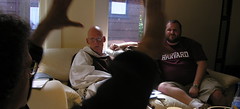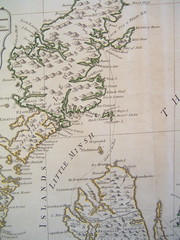Longevity map of the US
 NPR has just published a piece on Charles Murray's findings that link longevity with income and where you live in the US.
NPR has just published a piece on Charles Murray's findings that link longevity with income and where you live in the US.The study maybe isn't so surprising, considering that we've long known that different patterns of income, nutrition, and community life are associated with different American geographies. According, for instance, to the "nine nations" theory of Joel Garreau (or historicized in the book Albion's Seed by David Hackett Fischer), the different areas were settled in vastly different cultural epochs, and since have attracted extremely very different streams from the great pool of immigrants. We know this is true: travel across America even today, and you pass through a string of different cultures, widely varied according to their politics, house-building, community structure, sense of appropriate gender roles, and religious expression.
Murray's research emphasizes a crucial point: longevity is linked to community structure. We live longer when we live in sustainable communities, surrounded by strong social ties.
He cites American Indians as another example. Those who don't live on
or near reservations in the West have life expectancies similar to that
of whites.
Similar research has been borne out in European studies of happiness and longevity.
But why, then, in the text that accompanied map, did the NPR article emphasize not
culture and geography but race? The findings compare Asian-American women in New Jersey (averaging 91 years) with Native American men in South Dakota (averaging 58 years). The parallels that came to the author were equally racial as geographical: "That's like comparing women in wealthy Japan with those in poverty-ridden Nicaragua." Race creeps in to the narrative, no matter how much the research itself emphasizes community structure (and history as embedded in geography) as the real causation.
The risk here is that it becomes very easy for public health experts to emphasize how implicit and beyond control the factors governing longevity are: they have to do with individual choice (did you leave the reservation?) or inborne racial makeup (beyond your control) -- both of which are beyond the bounds of the appropriate sphere for public intervention.
Historians like me know enough to get good at imagining the nightmare scenario. So take health insurance and this research and its implicit racial analysis masked as health concern to its logical implication. Project twenty years into the future. There you are before your health care provider. Oh, you made the wrong choice about where to live. You left the reservation to get a higher education. Let's double the rate of insurance payments. Or better yet: look, I'm sorry; you turn out to be an African American from the poor South. That means you'll probably contract diabetes and die young. Double the insurance payments for you.
This is how the logic of public health works now. Make the wrong choice about where to live and the burden is yours. Be cursed as the victim of a race that has suffered social inequality, and the burden of pulling up your physical health by your bootstraps is yours as well.
So it should be interesting to see what sort of policy debate comes in reaction to Murray's research, with its problematic ellision of community, geography, choice of residence, and race. Murray concludes with a call for government intervention. We would do well to wonder what sort of government intervention he would call for:
"If I were living in parts of the country with those sorts of life
expectancies, I would want ... to be asking my local officials or state
officials or my congressman, 'Why is this?"'This more
precise measure of health disparities will allow federal officials to
better target efforts to battle inequalities, said Dr. Wayne Giles of
the Centers for Disease Control and Prevention, which helped fund
Murray's work.
I have sketched out some of the grim legislative alternatives: recognizing the highest risk areas (which are implicitly defined by race) and leaving them to their own futures.
The other alternative -- which i doubt will be taken -- would be to emphasize community. Community is the environment that determines the most about your happiness or longevity. A far-sighted public health-centered approach, whether undertaken by private insurance or public government -- might emphasize the good that could be done by emphasizing the social strengths of each community and propagating them: propagating religious, social, educational, community, arts-centered, charity-centered programs across communities, with great geographically, ethnically, and culturally specific variety.
Imagine if all American communities had the social and cultural bounty and support of Reservation communities and New Jersey Chinese immigrants, with their community care for the elderly, ritualized calendars, and strong family structures? How much more of a physically and mentally healthy America might we be then?
Technorati Tags: health, map, cartography, longevity, public health, health insurance, government, community, mental health, immigrants, immigrant culture, reservation, arts, charity, education, religion, libertarian, centers for disease control and prevention, charles murray, nine nations, albion's seed, life expectancies, race, racism, joel garreau, david hackett fischer, geography, social geography, cultural geography, sociology, life expectancy, income, public policy










0 Comments:
Post a Comment
<< Home